Experience Bonn from A to Z
Enchanted castles and fortresses, countless museums and nature right on your doorstep – welcome to Bonn, the former federal capital of Germany. The place to which we have long since lost our hearts. And maybe you will do the same soon?
We would like to introduce you to your future working environment and show you why it is worth living in Bonn. Come with us on a virtual journey through Bonn and stroll with us through the legendary Kirschblütenallee, the old Wilhelminian quarters and along the magnificent Rhine promenade. We’re in the mood for Bonn – you too?
A
Alter Zoll
At the southeastern end of the old town, below the main university building, is the Alter Zoll. It is a former bastion of the Bonn city fortifications, which offers you a magnificent panoramic view of the Rhine and the Siebengebirge. Where the customs house once stood to collect the Rhine duties, there is now a large beer garden. In summer, especially students come together here to enjoy a cool drink on the long beer benches under the ancient plane trees.
B
Beethoven
Bonn, this is Beethoven. In 1770 Ludwig van Beethoven, the world-famous classical composer, was born in the house at Bonngasse No. 20 and spent the first 22 years of his life there before he moved to Vienna. You can still visit the building today. It serves as a memorial, museum and cultural institute at the same time and is appreciated by music lovers and experts from all over the world as a place of meeting and exchange. In 2020, the city of Bonn will celebrate Beethoven’s 250th birthday together with Germany and the whole world. In the period from 16 December 2019 to 17 December 2020, various events such as concerts, exhibitions and theatre performances in honour of Beethoven will take place and make the “Beethoven Anniversary Year 2020” a very special one for Bonn and its inhabitants.

Bonner Bogen
On the right bank of the Rhine between the districts of Oberkassel and Ramersdorf, in the shadow of the southern bridge, a new area is beginning to develop: the Bonner Bogen. Once the headquarters of a cement factory, today numerous office buildings, restaurants and the exclusive 5-star design hotel Kameha Grand Bonn are located here directly on the promenade along the Rhine. In addition to the modern office buildings that are being newly constructed here, the original 19th century buildings can still be admired, including the old water tower, the directors’ villa and the Rohmühle.
Bonner Loch
Just a few years ago, the “Bonner Loch”, an entrance with several staircases that connected the city centre with the underground part of the station, was located directly in front of the entrance to Bonn’s main station. The “Bonner Loch” had its origins in the 1970s, when the city planner Friedrich Spengelin designed a terraced square for the newly constructed subway station, which should make it possible to descend to the subway.
After the Bonner Loch had been completed in time for the Bundesgartenschau, the site was then treated rather poorly and, over the years, became an urban blot. Especially in its last years, the Bonner Loch had become a preferred meeting place for homeless people and drug addicts and thus an urban problem zone.
But this now belongs to the past. Where once the Bonner Loch was located, there is now the Maximiliancenter: a four-storied building that houses a shopping arcade in the basement and a textile discounter on the other floors.
Botanical Gardens
With the Botanical Gardens, the University of Bonn maintains one of the oldest documented and most traditional botanical gardens in Germany. Approximately 11,000 plant species are cultivated on approximately 12 hectares. The Botanical Gardens are spread over a total of three locations, with the historic palace garden at Poppelsdorf Castle making up the largest and most famous part. The Botanical Gardens are open to visitors every day except Saturdays. During the winter months (1 November to 31 March) the gardens are closed on Sundays. Please note the shortened opening hours.
C
Carnival
Bonn is one of the carnival hotspots in Rhineland and does not have to hide behind the even bigger carnival in Cologne. In fact, Weiberfastnacht, the starting signal for the street carnival on Thursday before Ash Wednesday, has its origin in Bonn-Beuel. In 1824, the Beuel washerwomen decided that they did no longer want to accept that carnival was reserved for men only while they had to work. Even today, the washer princess and her ladies’ committee storm the town hall to cut the men’s ties. For six days there are celebrations and parties throughout the whole city. On Ash Wednesday, carnival comes to an end.
Cherry blossom
It’s a spectacle that is hard to imagine Bonn without: the Japanese cherry blossom that plunges the old town of Bonn into a sea of pink flowers every April. Every year, countless tourists come to Bonn to get their own impression of this unique natural spectacle. The trees were planted in the 1980s in the course of a district redevelopment and achieved international fame when the Facebook page “Places to see before you die” declared the cherry blossom in Bonn to be one of the absolute must-sees worldwide.
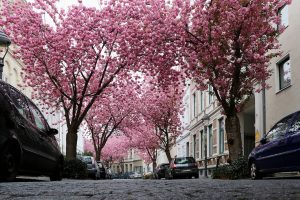
Christmas market
The Christmas Market of Bonn is one of the most popular Christmas markets in North Rhine-Westphalia. Every year from the end of November on you can find delicious gingerbread stands, hot wine stalls and all kinds of other delicacies in large parts of the city centre. Many craftsmen present a large selection of their decorative and practical goods for sale around Münsterplatz, Bottlerplatz and Friedensplatz. The Christmas Market of Bonn is always worth a visit and invites you to linger even in icy temperatures.
Climate
Bonn is characterized by a mild climate with little snow in the winter and hot and humid summers. With an average annual temperature of 10.3 degrees, Bonn is one of the warmest regions in Germany. This is not least due to its location in the basin between the northern foothills of the Eifel and the Siebengebirge mountains.
Cost of living
Recent studies show that living in Bonn is expensive. Almost every second household has to spend more than 30 percent of its net income on cold rent. This is more than in most other German cities. In a nationwide comparison, the city ranks 19th with an average rent of 9.15 euros per square metre.
But the people of Bonn also spend a lot of money on food. However, this is mainly due to a change in society that is leading to a more conscious, sustainable lifestyle – and this is also reflected in food prices. All products, including organic food, are still available at comparatively low prices in the discount stores, with which many other countries can hardly keep up.
What is also expensive in Bonn is transportation. The city, for example, performs poorly in a Germany-wide comparison for daily and monthly tickets. Tickets here are up to 70 percent more expensive than in other German cities.
Culture
Bonn has a lot to offer from a cultural point of view. The city has a large number of important museums. These include in particular the five museums of the Musemsmeile south of the city centre. The Musemsmeile includes, among others, the Haus der Geschichte, which vividly depicts German contemporary history since 1945. The Haus der Geschichte is one of the ten most visited museums in Germany.
But also for music lovers Bonn is the place to be. The city’s symphony orchestra regularly holds concerts in the Beethovenhalle, which has been closed since November 2016 due to renovation works.
Those who like theatre will love Bonn. With the Bonn Opera and the Schauspielhaus Bad Godesberg, the city operates two large institutions in which plays and operettas are regularly performed. In addition, the city is home to several private theatres, which also show cabaret.
D
Dialect
The dialect of the Bonners is called Bönnsch. The Bönnsch resembles the more northern Kölsch, but is characterized by a softer pronunciation of the consonants and a slower speaking speed. In many places Bönnsch is still spoken in private, but in public it has almost completely disappeared.
Drachenfels
The Drachenfels (“dragon’s rock”) is probably the most famous mountain in the Cologne Bonn region. Every year countless tourists visit the Siebengebirge to see for themselves whether this was the place where knight Siegfried defeated the dragon from the Nibelungen saga and thus saved the king’s daughter. But the Drachenfels is also a popular destination for hikers. If you are not so good on foot, you can either take the Drachenfelsbahn or the back of a donkey to the summit. Drachenburg Castle on the northwestern slope of the Drachenfels is also very popular with visitors.
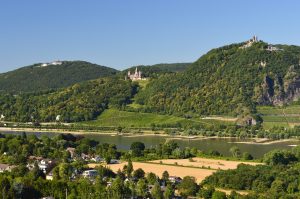
E
Economy
The city of Bonn has a strong economy. In 2016, the GDP was 71,222 euros per capita, well above the national average. Bonn thus generated the highest economic output in NRW, ahead of Cologne and Düsseldorf. This is not least due to the numerous large corporations, federal authorities and other national and international institutions and NGOs based in Bonn. This makes the Bonn region a prosperous business location with very good prospects for the future.
F
Federal City
Bonn is the only city in Germany called “Federal City”. This refers to Bonn’s former function as the federal capital, which the city carried until German reunification in 1990. Six federal ministries still have their headquarters in Bonn. Many other federal authorities are also located in Bonn. Numerous buildings, which were built in the times of the old federal capital for federal affairs, can be visited today. Among them are the Villa Hammerschmidt (official residence of the Federal President) and the Kanzlerbungalow (former residential and reception building of the Federal Chancellor).
G
Gastronomy
Bonn is distinguished not least by its cultural diversity. People from 177 different nations are said to be at home here. This is also reflected in the gastronomy. The culinary offer in Bonn is as large as hardly anywhere else. From the traditional Rhineland Sauerbraten in a cultivated brewery atmosphere to pan-Asian crossover cuisine and exclusive star restaurants, Bonn has all kinds of culinary delights to offer.

H
Haribo
Many well-known companies have their headquarters in Bonn. These also include the Haribo, which achieved international fame with its gold bears. Almost 100 years ago, the Haribo company was entered in the Bonn Commercial Register and has since manufactured fruit gums and liquorice products in Bomm. In May 2018 the company moved to the town of Grafschaft, but Haribo is still inevitably connected to Bonn. This is not least due to the name itself. “Haribo” is an acronym that refers to the company founder and his homeland: “Hans Riegel Bonn”.
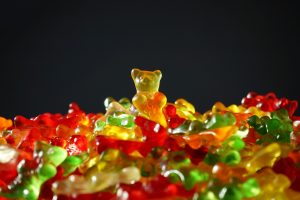
I
Infrastructure
With its central location between Cologne and Koblenz, Bonn has an excellent infrastructure. Bonn’s main railway station is regularly served by numerous local and long-distance trains. The stations in Bonn-Beuel (direct connection to the airport) and in Siegburg (connection to ICE Cologne-Frankfurt) are also very important. With Cologne/Bonn Airport, located about 15 kilometres northeast of Bonn, the city has an international airport that is ranked 6th in Germany in terms of passenger numbers. Bonn is also well positioned in local public transport. With about 30 bus lines and 6 light rail lines, the city has a comparatively dense tram and bus network.
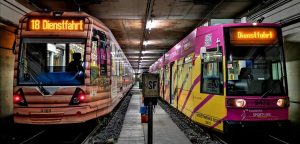
Inhabitants
With over 327,000 inhabitants, Bonn is one of the twenty largest cities in Germany and one of the ten largest cities in North Rhine-Westphalia. Although Bonn officially belongs to the big cities, over the years the city has been able to preserve its tranquil small-town charm. Everywhere you meet familiar faces, but at the same time you can benefit from the cultural offer of a big city. This is also what many Bonners like so much about their home town.
K
Kanzlerbungalow
In the park between the former Federal Chancellery and Palais Schaumburg is the Chancellor’s bungalow, which served as the residence and reception building for the German Chancellors between 1964 and 1999. With its floor-to-ceiling windows and bright, openly designed areas, the single-storey building is considered an outstanding example of the German 1960s architecture. A small permanent exhibition is located in the entrance area. It can be visited individually or in groups.
L
Labour market
Bonn has one of the lowest unemployment rates in North Rhine-Westphalia for. In June 2019, the unemployment rate in the Bonn/Rhein-Sieg region was 5.3 per cent. One reason for the low unemployment rate is the federal ministries and authorities based in Bonn, which offer numerous jobs. Other big companies such as Deutsche Post, Telekom and Postbank also have their headquarters in Bonn. As a UN city, Bonn attracts many international organizations with employees from all over the world. This makes Bonn one of the most attractive business locations in the whole of NRW.
M
Minster
One of the city’s landmarks is Bonn Minster. It is the city’s main cathedral and a Roman Catholic church built in 1248. Bonn’s cathedral is located in the middle of the city centre and thus offers inhabitants and tourists a place of silence and prayer amidst the hectic hustle. Due to a general renovation, Bonn Minster is unfortunately closed at the moment.
Museumsmeile
Bonn has an extremely rich and varied range of free time and cultural activities. This is not least due to the Museumsmeile (“Museum Mile”), an ensemble of five museums located in close proximity to each other. The first one is the Museum König, located on Adenauerallee, one of the largest natural history museums in Germany. Only a few hundred metres further along Willy-Brandt-Allee are the Haus der Geschichte, the Kunstmuseum and the Bundeskunsthalle, which attract visitors from all over the world with their permanent and temporary exhibitions. The Museumsmeile ends with the Deutsches Museum Bonn, a branch of the Deutsches Museum in Munich, which presents contemporary science and technology. With over 1.5 million visitors annually, the Museumsmeile Bonn is not only one of the largest museum associations in Europe, but also one of the city’s tourist highlights.
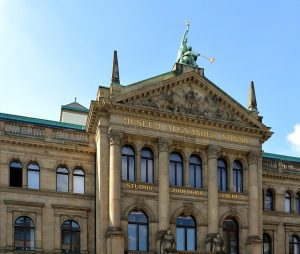
N
Name
The origin and meaning of the place name Bonn are still not clearly clarified. Some sources report that the name goes back to a settlement of Celts who settled in the Middle Rhine Valley around 600 BC. In Celtic bona means “foundation” or “tribe”. Another interpretation is based on the meaning variant “sole, pedestal”. The pedestals in the Bonn city area were already inhabited in pre-Roman times.
Nature
Despite its dense population, the city of Bonn also has a lot to offer for nature lovers. The city lies on the edge of the Siebengebirge mountains, which attracts countless day tourists with its world-famous Drachenfels. But also the Kottenforst, located west of the city, with its approximately 40 km2 and its diverse fauna and flora, is not only one of the largest forest areas in the region, but also a popular destination for families, hikers and ornithologists. In the city centre, numerous parks, including the Hofgartenwiese and the Rheinaue, invite you to linger.
Nightlife
There are no large nightclubs in Bonn. However, people in Bonn can choose from a wide range of scene bars, trendy clubs and alternative discotheques, where, in addition to charts and 90s music, there is always a programme directed at a niche audience. Above all, student and cult pubs are numerous in Bonn and invite you to linger. Whether in the Südstadt, the Old Town or the city centre – a good beer in a pleasant atmosphere can be enjoyed (almost) everywhere in Bonn. And if you prefer something bigger and hipper, you still have the possibility to go to nearby Cologne. The train takes you in less than 30 minutes directly from Bonn Central Station to the centre of the Cologne party scene.

O
Old Town Hall
The historic Old Town Hall on the market square is one of the most important buildings in Bonn and one of the city’s landmarks. It was built in 1737 and 1738, but was not completed until around 1780. With its striking gilded staircase, the Old Town Hall was an important venue for state visits, especially during Bonn’s era as a capital city. Famous personalities as Queen Elizabeth II, John F. Kennedy and Michail Gorbatschow have already been received here. The Old Town Hall lost its function as the seat of the city administration in 1978 as a result of the incorporation of Bonn, but it still serves today as the official and representative seat of the mayor and not least as a popular photo motif during a visit to Bonn.

P
Palaces and castles
Bonn and its surroundings are known nationwide for their multitude of magnificent castles and palaces. These include above all the Electoral Palace in the heart of the city, which used to be the residential palace of the Prince-Electors of Cologne and now serves as the main building of the University of Bonn. The tranquil Poppelsdorfer Allee connects the Electoral Palace with the Poppelsdorf Palace. Today the baroque building is listed as a historical monument. Schloss Drachenburg is still counted as one of Bonn’s castles, although strictly speaking it is part of the neighbouring town of Königswinter. The palace lies below the Drachenfels and is one of the most important German palaces of the late 19th century. Above Bad Godesberg lies Godesburg Castle, a ruin that was probably built by the Franks as an escape castle. Today the Godesburg houses a restaurant.
Post Tower
With its 162.5 metres, the Post Tower in Bonn stands above everything. It is not only the tallest office building in Bonn and NRW, but also the tallest German skyscraper outside Frankfurt am Main and the eleventh-largest skyscraper in whole Germany. The Post Tower was completed in 2002 and is now the headquarters of the Deutsche Post DHL Group. It is possible to visit the Post Tower. The tours last about 1.5 hours and are offered in German and English.

Prejudices
Bonn could not get rid of his reputation as a “federal village” until today. The name goes back to the post-war period, when Bonn won against Frankfurt and became the capital of the Federal Republic of Germany virtually overnight. Thus not only NRW won against Hessen, but also the province against the metropolis. The decision was smiled at in many places and not only once did the press mock the new seat of government as a “federal village”.
That the former city of 100,000 souls would develop into a real capital over the years would not have been thought possible by many. And although the politicians went back to Berlin after 40 years, Bonn managed to take advantage of this structural change. Today the city is not only the second federal political centre, but also the UN-City in Germany. And despite all the prejudices, Bonn can score above all with one thing: with its internationality, which does not detract from the small-town charm of the “federal village”.
Pützchen’s market
Pützchen’s market is a traditional day fair whose origins date back to the 14th century. Today the fair is very popular among young and old people with its numerous rides, snack stalls, confectionery stands and bars. Every year on the second weekend in September more than one million people come to Pützchen’s market. The great finale for Pützchen’s market is a large fireworks display, which usually takes place on Tuesdays.
S
Siebengebirge
The Siebengebirge (“Seven mountains”) is a low mountain range located southeast of Bonn. Contrary to popular belief, it does not consist of seven mountains but of more than 40. The origin of the name “Siebengebirge” is not clear. Some assume that the number refers to the seven main peaks, which can be seen from a distance depending on the viewing direction. Still others suspect that the seven symbolizes the whole. According to a legend, seven giants are responsible for the formation of the Siebengebirge. When they excavated the Rhine and cleaned their spades after their work, the mountains of the Siebengebirge remained behind. Today, the Siebengebirge is very famous among hikers, cyclists and nature lovers. Particularly on weekends, countless outdoor fans come to the Siebengebirge, with the Drachenfels being the biggest attraction.
Stadthaus
Located on the southern border of the northern city, the 72 m high Stadthaus is a striking focal point in the silhouette of the city. Built in the 1970s, the architecture of the building followed the idea of an “urban dominant” that was widespread in post-war modernism and consisted in being visible from afar. Due to its dominant effect on the surrounding area, the Stadthaus is today subject to widespread criticism. The service centre of the city of Bonn is located in the Stadthaus. Among other things, you have to make an appearance here if you want to register a residence in Bonn. HereLocation will be happy to assist you with that.
R
Rheinaue
The Rheinaue is a local recreation area of approx. 160 hectares, which extends on both sides of the Rhine in the middle of the Bonn city area. The park was created on the occasion of the Bundesgartenschau in 1979, a biennial federal horticulture show, and is now used for major events such as open-air concerts and flea markets.
Rhine
What would Bonn be without the Rhine? On its way from the source in Switzerland to its mouth in the North Sea, the second longest river in Germany also flows through Bonn and has a lasting influence on the cityscape. One of the reasons for this is that the Rhine flows right through the city. The districts on the left bank of the Rhine make up about three quarters of the total area. Along the Rhine there are numerous cultural highlights, starting with the Beethovenhalle and the Alter Zoll in the north, via the Post Tower and the Langer Eugen in the direction of Bad Godesberg up to the legendary Drachenfels a little further south above Königswinter. Throughout the year, the Bonner Personenschifffahrt offers cruises over the Romantic Rhine. The highlight of the year is the Rhein in Flammen, a fireworks spectacle which always takes place on the first Saturday in May.
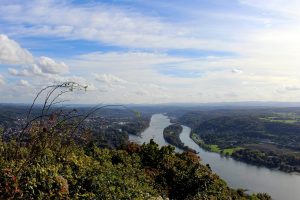
T
Tourism
Bonn has recorded enormous growth rates in the sector of tourism in the last couple of years. On the one hand, this is due to its scenic location on the Rhine and the Siebengebirge. But also the proximity to the international airport Cologne-Bonn makes the city a popular destination for a weekend trip. The city experienced a noticeable increase in visitors as a result of the marketing of the cherry blossom, which attracts countless visitors from all over the world to Bonn’s old town every year in April. Bonn was last ranked 5th among the top destinations for 2020 by the travel guide Lonely Planet. The city is now preparing for a lively visitor rush in the Beethoven anniversary year.
U
UN-City
The Federal City of Bonn has been the seat of various United Nations organizations since 1951, but only since 1996 has it referred to itself as the “Germany’s UN-City”. Around 1,000 employees work on the UN campus in Bonn, most of them in the “Langer Eugen”, a high-rise building in the Gronau district, which served as the main location for the offices of the members of the German Bundestag until it moved to Berlin in 1999. Today, the city attracts numerous international professionals to Bonn, not least because of its position as a UN-City.
University
The University of Bonn (German: “Rheinische Friedrich-Wilhelms-Universität Bonn”) was founded in 1818 and is today one of the largest and most renowned universities in Germany. The faculties of mathematics, physics, economics and agricultural sciences enjoy a special reputation. The Bonn Law School also enjoys a high international reputation. Among the university’s 371 buildings distributed throughout the city, the Electoral Palace is not only the main university building, but also one of Bonn’s landmarks.
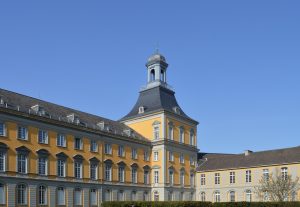
V
Venusberg
Those who leave the city centre of Bonn in southwest direction will reach a densely wooded hill chain on the city area, whose highest point is at 171 m: the Venusberg. But the name has neither something to do with planets nor with roman goddesses. It is derived from the Dutch “Fenn”, which refers to the former high moorland in the area of the Venusberg.
Today, the Venusberg is home to the Kottenforst forest and a residential area, as well as the University Hospital of Bonn, which conducts research in the fields of genetics, immunology and neuroscience, among others. Popular for families and children is the Waldau, where you can visit a wildlife reserve with wild boar, red deer and fallow deer.
Villa Hammerschmidt
The Villa Hammerschmidt has served as the official residence of the President of the Federal Republic of Germany since 1950. Even after Federal President Richard von Weizsäcker’s decision in 1994 to move the official residence of the head of state to Schloss Bellevue in Berlin, the Villa Hammerschmidt remained the Federal President’s secondary residence. When the Federal President is staying there, this can be seen from the hoisted flag on the roof. Since the imposing building in the classicist style bears a certain resemblance to the White House in Washington, it is also called “The White House on the Rhine”. With its 50,000 square metres of gardens directly on the Rhine and in the immediate vicinity of Palais Schaumburg, Villa Hammerschmidt still radiates a very special atmosphere today.

